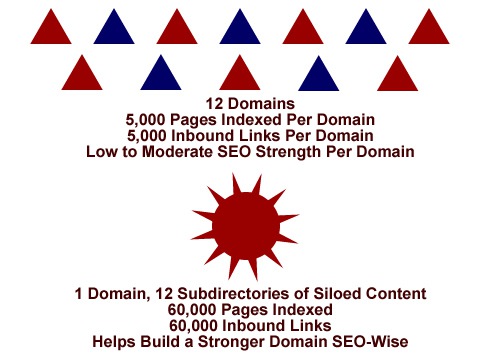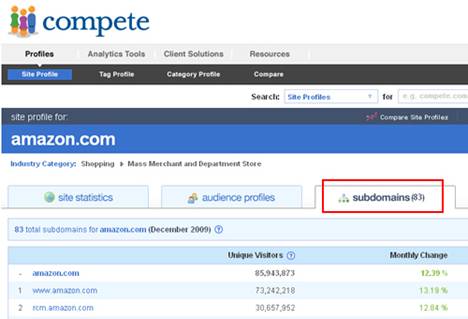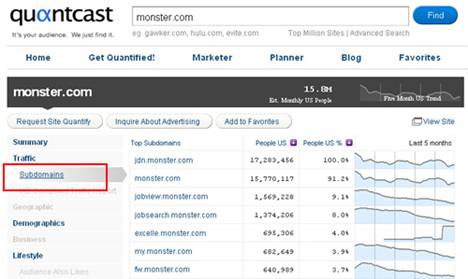When it comes helping clients with natural search, I’m a firm believer that SEO technical audits are an incredibly important first step for most engagements. I’ve already written about the power of technical audits and how they often can provide the most SEO bang for your buck. The reason is simple. In SEO, without a clean and crawlable website structure, you’re dead in the water. You can build links and optimize content until the cows come home and it probably wouldn’t make much of a difference.
Although SEO audits detect problems with indexation, canonicalization, navigation and internal linking structure, content optimization, sitemaps, handling advanced functionality like AJAX, etc., there’s another important component that is sometimes overlooked – Domain Strategy. Understanding all of the domains and subdomains being used by a company is critically important for maximizing SEO strength. If a company overlooks domain strategy, it just might be missing an opportunity to make a strong impact, and without major development. The combination of “fast” and “no development” is a great way to show results without signing a declaration of war with your IT department (like the rest of your audit might do.). 🙂
Why Is Domain Strategy Important for SEO?
Domains build search power. For most companies, this involves building as much equity and strength for their core domain as possible (www.domain.com). If a company ends up having twelve separate domains, all focused on the same vertical or subject matter, then it can be splitting its search strength across those domains. In addition, the excessive use of subdomains could be causing problems or exposing security holes for the company. Between building search equity and minimizing security concerns, domain strategy can be a very important part of your audit.
For example, let’s say the twelve domains I mentioned above (all focused on the same vertical) each have 5,000 pages indexed and 5,000 inbound links. They all have low to moderate SEO power and each is struggling to rank for target keywords. Imagine you were able to combine those domains and organize them in logical subdirectories (where you can silo content by category). Then you would have 60,000 pages indexed and 60,000 inbound links for one domain. You can start to build more strength in the core domain and leverage all of your valuable content to build traffic, links, and ultimately more search power (and better rankings).
Splitting SEO Strength Across Domains:

Most website owners should focus on building strength and equity in their core domain (via high quality, unique content and then building topical and relevant inbound links). If you split those efforts across a number of domains, then you can water down the effect (to say the least). I’m not saying to always have just one domain (especially if you’re a large company that focuses on several verticals or has multiple brands). But, don’t have 15 domains per brand, 250 domains for marketing campaigns, or 300 subdomains for random purposes. More on situations like these soon.
Real-World Examples of When a Domain Strategy Was Needed
Below, I’ve provided several situations that I’ve come across while performing SEO audits where developing a domain strategy was desperately needed.
The Disconnected Blog
 Your company is wondering why its blogging hasn’t impacted natural search power for its core site (where all of its products and services are listed). Upon further investigation, the company has two blogs and both have been set up on separate domains (outside of the core website.) i.e. www.domain.com, www.domain-blog.com, and domain.blogspot.com. All three domains are building up their own search power, and the two blogs aren’t building strength for the company’s core website. And of course, the core website has the least strength of all. {I see this often by the way.}
Your company is wondering why its blogging hasn’t impacted natural search power for its core site (where all of its products and services are listed). Upon further investigation, the company has two blogs and both have been set up on separate domains (outside of the core website.) i.e. www.domain.com, www.domain-blog.com, and domain.blogspot.com. All three domains are building up their own search power, and the two blogs aren’t building strength for the company’s core website. And of course, the core website has the least strength of all. {I see this often by the way.}
The In-House Domainer
 I was in the middle of an SEO audit and I requested a list of all domains actively used by the company. The CTO dropped a ten page list of domains and subdomains on my desk. That’s 10 pages of domains and not 10 domains… After being brought back to consciousness via smelling salt, I knew there was a big problem to tackle. 🙂 Ultimately, the CMS being used forced the company to set up subdomains versus subdirectories when adding specific types of new content to the site. Don’t ask why… So, the company had hundreds of subdomains, and some only had one or two pages on the entire subdomain. In addition, requesting the list and reviewing it with my client revealed about a dozen subdomains that shouldn’t have been active in the first place.
I was in the middle of an SEO audit and I requested a list of all domains actively used by the company. The CTO dropped a ten page list of domains and subdomains on my desk. That’s 10 pages of domains and not 10 domains… After being brought back to consciousness via smelling salt, I knew there was a big problem to tackle. 🙂 Ultimately, the CMS being used forced the company to set up subdomains versus subdirectories when adding specific types of new content to the site. Don’t ask why… So, the company had hundreds of subdomains, and some only had one or two pages on the entire subdomain. In addition, requesting the list and reviewing it with my client revealed about a dozen subdomains that shouldn’t have been active in the first place.
LOST – The Disappearing Campaign
 You know those killer marketing campaigns that sometimes build thousands of links (like the one you just shared with all of your friends on Facebook and Twitter?) The domains used for those campaigns can end up having an important impact on your SEO efforts. Viral content can be great for attracting a lot of links as campaigns take hold. Unfortunately, some companies (cough, larger brands) tend to use campaign-based domains. So, if you were launching a campaign for a new golf driver that could add 50 yards to your drive, then you might use a domain like www.cannon-driver.com or something like that. As you can guess based on what I’ve written above, this new domain won’t help your core website (as it’s on a separate domain) and it also won’t leverage your core domain’s search power. To makes things worse, many brands that use campaign-based domains turn off those domains when campaigns are over. This can waste thousands (or tens of thousands) of hard-earned links! If you are forced to use campaign-based domains, then you could implement 301 redirects after the campaign is over to make sure the pages being taken down point to new pages on your core domain (like the section about a new product). You would want to do this on a page per page basis. That said, I almost always recommend setting up campaign landing pages on the core domain. i.e. www.domain.com/cannon-driver/. Then you don’t need to worry about the 301 redirection plan down the line.
You know those killer marketing campaigns that sometimes build thousands of links (like the one you just shared with all of your friends on Facebook and Twitter?) The domains used for those campaigns can end up having an important impact on your SEO efforts. Viral content can be great for attracting a lot of links as campaigns take hold. Unfortunately, some companies (cough, larger brands) tend to use campaign-based domains. So, if you were launching a campaign for a new golf driver that could add 50 yards to your drive, then you might use a domain like www.cannon-driver.com or something like that. As you can guess based on what I’ve written above, this new domain won’t help your core website (as it’s on a separate domain) and it also won’t leverage your core domain’s search power. To makes things worse, many brands that use campaign-based domains turn off those domains when campaigns are over. This can waste thousands (or tens of thousands) of hard-earned links! If you are forced to use campaign-based domains, then you could implement 301 redirects after the campaign is over to make sure the pages being taken down point to new pages on your core domain (like the section about a new product). You would want to do this on a page per page basis. That said, I almost always recommend setting up campaign landing pages on the core domain. i.e. www.domain.com/cannon-driver/. Then you don’t need to worry about the 301 redirection plan down the line.
The Security Risk
 I ran across a situation during an audit where I found about a dozen subdomains being used. In total, there were a few thousand pages indexed and also a few thousand inbound links. When I presented this to my client, they weren’t aware that some of the subdomains existed, and definitely weren’t aware of the content residing on them. In a nutshell, some of the data indexed on the subdomains could be considered a security risk, and the engines should have been blocked from indexing it. After dealing with the security risk, we planned to 301 some of the other subdomains to directories and pages on the www subdomain. So, the company quickly moved to close a security hole and then was able to leverage content they didn’t know existed to help their SEO efforts.
I ran across a situation during an audit where I found about a dozen subdomains being used. In total, there were a few thousand pages indexed and also a few thousand inbound links. When I presented this to my client, they weren’t aware that some of the subdomains existed, and definitely weren’t aware of the content residing on them. In a nutshell, some of the data indexed on the subdomains could be considered a security risk, and the engines should have been blocked from indexing it. After dealing with the security risk, we planned to 301 some of the other subdomains to directories and pages on the www subdomain. So, the company quickly moved to close a security hole and then was able to leverage content they didn’t know existed to help their SEO efforts.
On a similar note, I’ve also seen situations where test servers were indexed. Yes, the new content you were planning on launching during the next website release was freely available for all for competitors to browse. Needless to say, you would want to lock down those test servers by authenticating users and blocking the search engines from indexing any content. That’s if they needed to be accessible in the first place.
Domain Strategy Recommendations:
If you are working on an SEO audit for your company or client, here are some quick recommendations that can help you identify all of the domains and subdomains being used by the company you are helping.
Ask About Domains
Ask your clients or IT department for a list of all domains and subdomains used by the organization. Although you can probably find them during your audit, the initial list they provide can be a great place to start.
Dig and Then Dig Some More
I’m an inquisitive guy, which part of the reason I love performing technical audits. During the process of auditing a site, you will naturally come across several of the domains and subdomains used by the company. Checking indexation and inbound links typically reveals hidden content, rogue domains, excessive use of subdomains, etc. Checking the IA and internal navigation can also reveal paths to subdomains and separate domains used. So dig, document, and create a list of all domains used.
Competitive Tools
There are a number of tools you can utilize to reveal subdomains used by a company. For example, Compete and Quantcast provide the ability to view subdomains for a given domain. That said, these tools don’t catch everything. They can help, but don’t rely on them for the full list.


Google and Yahoo
Using an advanced Google command can show pages indexed without the www subdomain. For example:
site:http://domain.com –inurl:www
Yahoo Site Explorer can also reveal subdomains indexed. Just make sure the tab for “show all subdomains” is active and that you don’t enter www when typing the domain. You’ll have to do some digging here, but you can often find several of the subdomains being used.
Dedicated Tools
Some developers in the security community have built tools to quickly check the subdomains of a given domain. Here’s a good one: http://www.magic-net.nl/dns-and-ip-tools.php. The second field labeled “search subdomains” is the one you want.
Summary
I hope this post helped explain the importance of developing a solid domain strategy for SEO, while providing some real world examples of when one was needed. After completing your research, you just might find that the company you are assisting doesn’t know all of the domains being used (or the power of each domain). Developing a strategy for removing, blocking, or leveraging those domains can help build more natural search power, while also decreasing security risks. At a minimum, it could stop your competitors from checking out your latest content before it’s officially released. 🙂
Glenn Gabe is an online marketing consultant at G-Squared Interactive and focuses heavily on SEO, SEM, Social Media Marketing, Viral Marketing and Web Analytics. You can read more of Glenn’s posts on his blog, The Internet Marketing Driver and you can follow him on Twitter to keep up with his latest projects, news, and updates.




